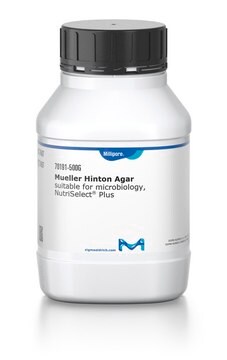A6686
Ágar
Bacteriological, microbiology tested, suitable for plant cell culture, granular
Sinônimo(s):
Ágar de goma, Ágar-ágar
About This Item
Produtos recomendados
fonte biológica
algae (Rhodophyceae)
Nível de qualidade
forma
granular
técnica(s)
cell culture | plant: suitable
pf
83-89 °C
temperatura de transição
transition temp 32-39 °C
adequação
microbiology tested
aplicação(ões)
agriculture
temperatura de armazenamento
room temp
InChI
1S/C14H24O9/c1-5-8(16)13-11(7(21-5)4-20-13)23-14-10(18)12(19-2)9(17)6(3-15)22-14/h5-18H,3-4H2,1-2H3/t5?,6-,7?,8-,9+,10-,11?,12+,13+,14?/m1/s1
chave InChI
GYYDPBCUIJTIBM-DYOGSRDZSA-N
Procurando produtos similares? Visita Guia de comparação de produtos
Descrição geral
Aplicação
- to culture Staphylococcus aureus for phage infection studies
- as a supplement with NZCYM media for culturing Campylobacter coli strains for lysogeny screening
- as a basic media component to improve in vitro ovule and embryo culture methods of cross Chitalpa hybrids to facilitate the rescue of triploids
- in the culture media for Bdellovibrio spp. and Micavibrio spp. strains to check their susceptibility towards a variety of select agents
Outras notas
Código de classe de armazenamento
11 - Combustible Solids
Classe de risco de água (WGK)
WGK 1
Equipamento de proteção individual
Eyeshields, Gloves, type N95 (US)
Certificados de análise (COA)
Busque Certificados de análise (COA) digitando o Número do Lote do produto. Os números de lote e remessa podem ser encontrados no rótulo de um produto após a palavra “Lot” ou “Batch”.
Já possui este produto?
Encontre a documentação dos produtos que você adquiriu recentemente na biblioteca de documentos.
Os clientes também visualizaram
Nossa equipe de cientistas tem experiência em todas as áreas de pesquisa, incluindo Life Sciences, ciência de materiais, síntese química, cromatografia, química analítica e muitas outras.
Entre em contato com a assistência técnica


